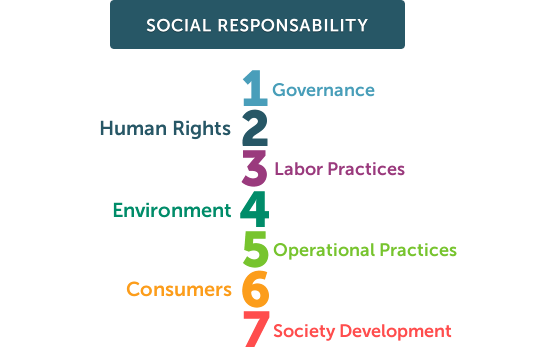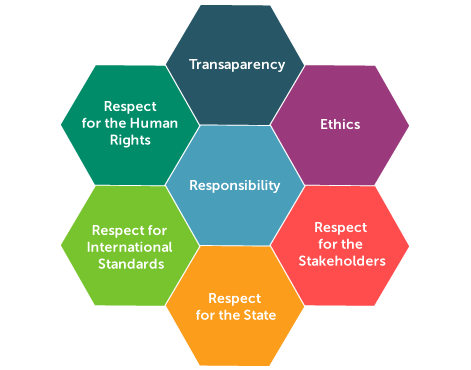ISO 26000
The ISO 26000 started in 2004, involving experts from more than 90 countries and 40 international organizations, was approved May 17, 2010 during the eighth meeting of the Working Group Session on Social Responsibility in Copenhagen in Denmark. This standard provides guidance on the fundamental principles of social responsibility, provides guidance on socially responsible behavior in organizational strategies. It aims to be useful to all types of organizations from the private, public and non-profit, whether large or small and regardless of the country where they operate.
Fundamental Themes of Social Responsibility

Social Responsibility issues associated with 7 themes
1- Government Organizations:
- Organization structure of adaptation;
- Transparency and ethical activities;
- Information, consultation and participation of stakeholders;
- Corruption and bribery / extortion;
- Relationships with suppliers;
- Relationships with customers / consumers;
- Investor relations / shareholders, including the empowerment of small shareholders.
2- Human Rights:
- Civil and Political Rights (ex .: the right to life, housing, privacy, family, freedom, etc.);
- Economic, Social and Cultural Rights (ex .: the right to work and food, with dignity, the right to freedom of thought, religion, sexual orientation and access to health and education);
- Equal Opportunities (ex .: gender equality, non-discrimination, conciliation between work and family).
3- Labour Practices:
- Labor and Employment (ex .: child labor and / or forced, freedom of association and collective bargaining, holiday social protection, harassment, etc.);
- Health and Safety at Work (ex .: occupational diseases, accidents at work, etc.);
- Professional Training and enhancement of Human Resources (ex .: skills development, careers, internships, employment, etc.).
4- Environment:
- Water consumption, energy, hazardous substances and materials;
- Land use;
- Effects on biodiversity and natural heritage, including the landscape;
- Emissions to air, including greenhouse gases, resulting from the organization's activities, including transportation of people and goods;
- Generation of waste, including hazardous waste;
- Noise, vibration, odor, dust, visual appearance and others with at local level.
5- Operational Practices:
- Value Chain (ex .: partnerships for the development of new products, fair trade, outsourcing, undue influence, etc.);
- Competitors (ex .: Behaviors "anti-cartel" and monopolies, fair competition, intellectual, industrial espionage);
- Public Institutions (ex .: exercise lobbying, cooperation with institutions, involvement in pursuit of public purposes).
6- Consumers:
- Health and consumer safety, Information content, safe use, maintenance, storage and disposal of goods and / or services;
- Resolution of conflicts and disputes (cost, speed, damage repair);
- Privacy and protection of personal data;
- Satisfaction needs and expectations;
- Quality of goods and services;
- Information, training and education for sustainable consumption;
- Guarantees;
- Advertising Responsible.
7- Development of Society:
- Education / training for life / formation of society and local communities;
- Cultural Heritage;
- Patronage / philanthropy / Volunteer / social activities, cultural and leisure / Public health / wellness / Community Involvement;
- Access to information / participation of citizens and organizations / public participation;
- Support local shops / Support for the development of the local community / local hiring;
- Conditions and factors affecting / improve the welfare and neighborhood living conditions (elderly, disabled, children, etc.).
Principles of Social Responsibility

Guidelines on the integration of social responsibility - Integrating social responsibility throughout the organization:
- Identification and reflection on the organization's characteristics and the relationship with the Social Responsibility (ex .: structure, mission, values, size, etc.);
- Understanding the organization's social responsibility, (ex .: (re) definition of the principles of social responsibility, identification and ranking of stakeholders and aspects of social responsibility, etc.);
- Practices for integrating social responsibility throughout the organization - development of an action plan, short, medium and long term- aimed at continuous improvement in order to minimize negative impacts and enhance positive impacts on their stakeholders;
- Commitment of top management for the implementation of the Social Responsibility model;
- Developing skills for social responsibility, creating a culture of social responsibility to cut across the company.
- Communication on social responsibility, both internally and externally to the organization in order to improve the dialogue and transparency for all stakeholders.
- Strengthening the credibility of social responsibility, by stakeholder involvement, participation in certification processes, and membership and collaboration with related social responsibility.
- Continuous improvement through monitoring, monitoring, evaluation and review activities and progress.







